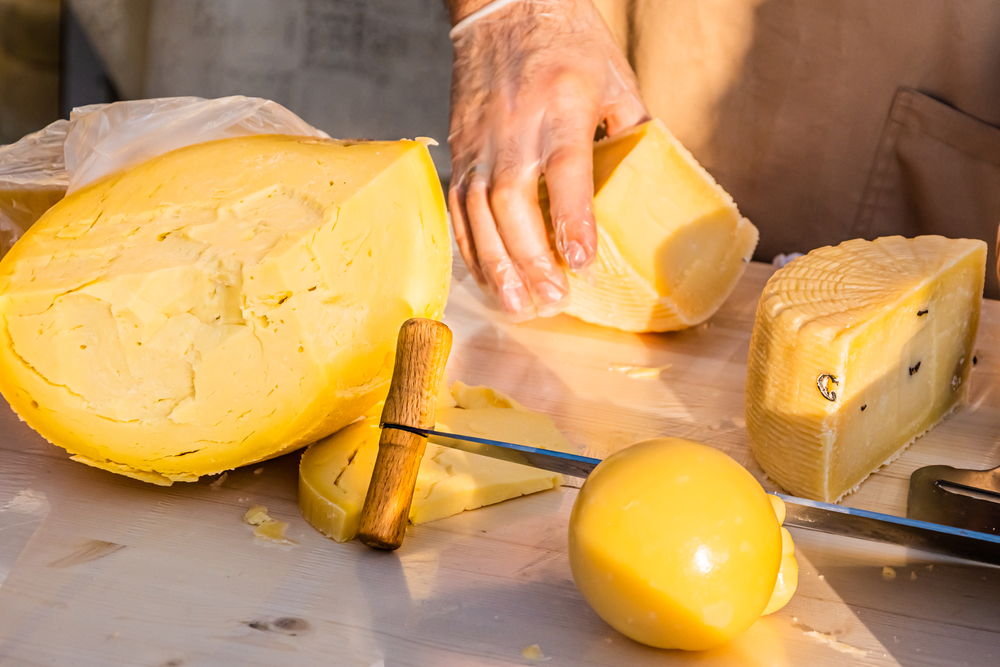We aim to obtain a self-reliant lifestyle that allows us to make pretty much anything we desire on our own.
As far as food preparation goes, making something from scratch not only provides you with an achievement feeling that is hard to describe, but you also discover the product to be healthier and better-tasting than the store-bought items. For the homesteader, this means better meat, produce, eggs, and dairy products.
Today, we will look at the ins and outs of making outstanding from-scratch dairy products, and the best part is that you don’t even have to own a cow to succeed. Try these recipes, and I guarantee they will become your family’s favorite.
Getting the milk
I can tell you from experience that unpasteurized milk (raw milk) makes the best-tasting products. Depending on what milk sources you have available, you can use cow, goat, sheep, and even llama milk. However, it should be noted that each type of milk brings its unique flavor and texture to the final product.
Some folks cannot obtain raw milk, while others are uncomfortable with the idea of using non-homogenized one, but even for them, there’s still a way to make things work. Using pasteurized milk or cream can also help you obtain those great-tasting dairy products. Just pay attention to buy only milk labeled “pasteurized” and not marked as “ultra-pasteurized” because this type of milk will not work.
Regardless of your milk choices, all the recipes listed in this article are adaptable, so no precise quantity of milk or cream is mandatory. This means that even if you don’t have large amounts of milk or sour cream, you can still make the products and get an idea of what satisfies your taste.
Butter types
There are two types of butter folks make, cultured butter and sweet butter. The cultured type is the type of butter your great parents used to enjoy, and it’s made using a cream that has fermented (or turned sour). The taste of cultured butter ranges from somewhat tangy to intensely sour. This distinctive taste is given by the type of sour cream being used and its characteristics. Each cream ferments at a different rate, and the cream’s ripeness varies in intensity.
If you want to make cultured butter, make sure you are using only raw cream because pasteurized cream will not ferment and needs to have cultures added to ferment correctly.
Sweet butter is the second type of butter you can try making at home, and this type of butter has a more modern flavor. It can be made using both raw cream and pasteurized whipping cream. Raw cream will help create a richer, more yellow butter than pasteurized cream, and the taste is, in general, much sweeter. On the other hand, pasteurized cream will help produce butter with a milder flavor, similar to the one you buy from the grocery store.
Making butter in a mason jar
Some folks will buy a butter churn, but if you’re trying to make butter for the first time and if you don’t plan on making a lot of it at one time, wait on that purchase. For your “experiment,” you can use a single quart-sized mason jar since it will be more than enough to make butter for a week or two. Other equipment needed would be a cheesecloth, a jelly-strainer bag, or a flour-sack towel.
Directions:
- If you plan on making cultured butter, you should let raw cream sour naturally in the fridge, but keep in mind that this process may last more than a week. Alternatively, you can pour the raw cream into a jar, cover it with a cheesecloth and let it sit in a warm place until it starts to smell slightly sour. Keep in mind that the more soured the cream you use, the more soured the butter will taste.
- As a general rule, once you make your first batch, you will adjust the time you allow the cream to sour before making the next batch. Experimenting will help you obtain that perfect flavor you and yours like. If you plan on making sweet butter, you can use raw or pasteurized cream.
- Pour the raw or pasteurized cream into a jar, cover it with a cheesecloth and let it sit on the countertop until the cream reaches room temperature. The trick here is to avoid letting the cream go over the room temperature because if it gets too warm, it will start to sour if the cream is raw. On the other hand, if you are using pasteurized cream, there’s a chance it will go rancid if you let it warm for too much.
- Place the jar lid and band onto the jar and briskly shake, making sure you slam the cream against the walls of the jar. Within 5 to 15 minutes, the cream will start to thicken, and a change in its movement will be easily observed.
- Once you see clumps of butter start to form and the mixture slides from the jar’s walls, reduce shaking to a somewhat moderate level.
- When you no longer notice any liquid in the jar and the jar’s walls are clear, you can pour the jar’s content into a cheesecloth to drain. Make sure you catch the liquid buttermilk in a container (preferably a glass one) for later use.
- Take a spoon and move the curds around while at the same time pressing out as much buttermilk as you can. Rinse gently with cool water until the water remains clear.
- You can place your butter into a bowl and add salt or other seasonings. You can store it covered in the fridge, or you can freeze it for later use.
Making sour cream
Here is my preferred recipe for making sour cream because I can adapt it using the quantity of cream I have, and I don’t need to get a starter culture.
Directions:
- Get a sterilized pint jar, place one cup or more fresh, raw cream (or pasteurized) in it.
- For every cup of cream, you will need to add two tablespoons of culture sour cream and gently stir to mix the quantities. For the cultured cream, you can use a store brought one as long as it is labeled to contain only “cultured cream” without fillers, or you can use a homemade batch of sour cream.
- Let the jar sit at room temperature for up to 24 hours. Anywhere from 12 to 24 hours should do it since the cultured sour cream will make it possible for the pasteurized cream to ferment safely.
- After 12 hours, you need to make various taste tests to ensure your sour cream has reached that level of tanginess you desire. Once you obtain a taste to your liking, you can refrigerate the sour cream and enjoy it for up to a week.
Making farmer’s cheese
You can make farmer’s cheese from pasteurized whole milk or raw milk. The simplicity of this recipe makes it an “a must-try experiment,” and the mild flavor of this farmer’s cheese also allows you to include various seasonings to obtain a different taste every time.
Directions:
- Get a saucepan and pour whole milk into it. Place it over medium heat and stir regularly until the first signs of boiling occur. The stirring will avoid scorching, and once you see the milk starting to boil, you should remove the saucepan from the heat.
- You need to induce curding with the help of an acid such as distilled vinegar, citric acid, or 100% lemon juice. The amount you need will vary by the batch you are using. As a general rule, for each ½ gallon of milk, you need to start with ½ teaspoon of citric acid and one tablespoon of distilled vinegar or lemon juice. After adding the acid, gently stir, and you will notice clumps of curds beginning to separate from the liquid whey. This happens almost instantaneously once you add the proper amount of acid.
- Once you notice the curds start to separate, allow the pot to rest for 30 minutes for all the curds to form.
- Take a colander and line it with a cheesecloth, then place it over a bowl. Pour the whey and curds into the colander to drain, and make sure you save the liquid whey for later use.
- Draining the whey will make sure you obtain a firmer cheese. The more whey you remove, the harder the cheese will be. For example, if you want to get a softer cheese similar to ricotta, you will have to leave some whey in the product.
- Once you drain the whey, season your cheese to taste. If you have obtained the desired texture and seasoning, you can place it in an airtight container and store it in the fridge for up to a week.
- You can shape your cheese as you like when the curds are formed. For example, you can flatten it into a circle and wrap it in cheesecloth. Now place it on a saucer and put some weight on the cheese to squeeze the remaining whey. Finally, you can store it in the refrigerator to drain overnight.
- The finished harder, and sliceable cheese can be wrapped in plastic wrap or waxed paper, and you can store it in the refrigerator for up to a week.
Concluding
As you can see in this article, making homemade butter, sour cream, and farmer’s cheese from scratch is a simple enough process that anyone can try. Regardless if you plan on using raw or pasteurized milk, you can’t go wrong with these recipes. Once you see how easy it is to make these dairy products, you will forget about their commercial counterparts, and I believe these will become your family’s favorite.








































































I do have a milk cow and make sweet butter. I simply skim off the cream as it rises on the milk. When I have a cup or two of cream, I pour it in my kitchen-aid mixer on low. I use the mixing paddle, not the wire wisk type or bread attachment. Any higher speed, and it splatters too much.. It is less tedious than constantly shaking a jar.. It is easy to tell when it is butter because it definitely clumps. Just one more method to try.
I would like to purchase “Forgotten Lessons of Yesterday” BUT I do not buy electronic copies. I want the physical copy in book form.
Is it available in book form.
Hello, Daniel. One of our colleagues will contact you via email Thank you for your interest.
I would like a physical copy as well
Hello, Sheri. One of our colleagues will contact you via email Thank you for your interest.
Yogurt: Bring one gallon milk to a rolling boil. Cover. When it cools, add a pint of raw yogurt. Stir, cover, set on back of stove for 12 hours for the original, sweet yogurt. Jar it, and let it sit out for 2-3 days for sour cream type. For cheese, reheat soured yogurt till it simmers. We do not add salt. The curd should break free. Line a bowl with a clean towel or cheese cloth, and fill it with curd. This should be hung overnight, over a bowl. It can be eaten as is or pressed, then salted. Whey was always a treat. It makes good popsicles (wheypops), or can be fermented if you like wine that tastes like sour milk (arakis). Cook with it or feed it to livestock.
I would like to purchase “Forgotten Lessons of Yesterday” BUT I do not buy electronic copies. I want the physical copy in book form
Thumbs up for this article.
cj
Hello, CJ Fietz. One of our colleagues will contact you via email Thank you for your interest.
I would like physical copy also. ….I bought electric copy but don’t know how to download load it. I’m 73 yrs old.
Hello, Catherine. One of our colleagues will contact you via email Thank you for your interest.
I really enjoyed this article. Thank you!
I would like to purchase the “Forgotten Lessons of Yesterday” in the physical book form, Please? Is it available?
Thank you !
Hello, Linda. One of our colleagues will contact you via email. Thank you for your interest.
Ditto for me as well regarding a physical copy of the Forgotten Lessons.
Thank you
Would like a physical copy also!